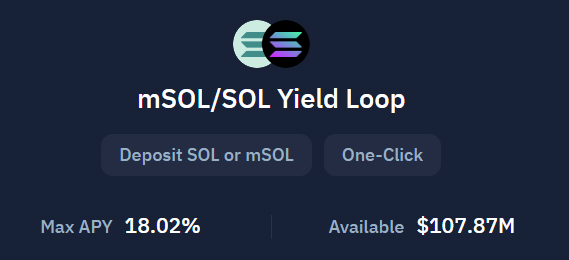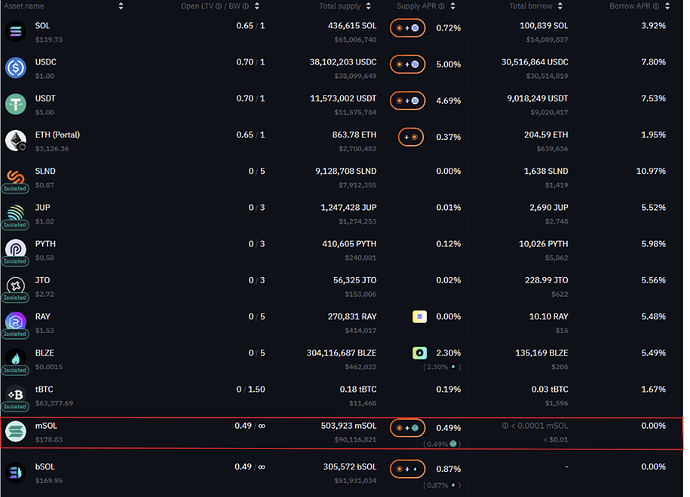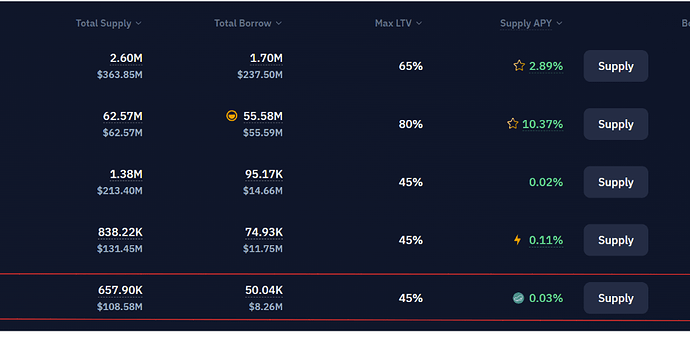TL;DR: we propose to allocate 50% of the requested budget (12.5 million $MNDE tokens) to deepen the liquidity of the $mSOL/$SOL vault on Kamino, 30% of the requested budget (7.5 million $MNDE tokens) to deepen the liquidity of $mSOL vaults on Kamino paired with already established and upcoming, i.e., hot Solana ecosystem, and the remaining 20% of the requested budget (5 million $MNDE tokens) to carry out a strategy on Solend to make looping from (collateralizing with) Meteora $mSOL/$SOL more profitable than with current $mSOL pools (like on Solend and Kamino) and other $SOL LSTs.
The main difference between Season 3 and Seasons 1-2 is that a core focus is placed on deepening the on-chain liquidity of $mSOL, a place where Marinade is lacking relative to other $SOL LST protocols like Jito. Furthermore, a lesson has been learned from previous seasons not to predefine (i.e., fix) rewards (e.g., 1 $MNDE in rewards for 2 $SOL staked with Marinade for 3 months, like it was done in Season 2) but rather adapt dynamically to market conditions and rewards offered by competitors like Jito using in-house modeling to stay competitive and pivot based on what the market is saying.
Hello Chefs,
As Marinade Earn — Season 2 has ended, the Marinade DAO must prepare for another season of rewards to stay competitive in the dynamic liquid staking token landscape and retain its spot as the largest DeFi protocol on Solana.
Before getting into the proposal, a quick summary of the Season 2 reward program from January 1st to March 31st, 2024, can be made to determine its efficacy.
-
The DAO allocated up to 25 million $MNDE tokens for Season 2 to be distributed in the three months from the start of January to the end of March.
-
The base rewards for both sets of stakers ($mSOL and Native) were 1 $MNDE token per 2 $SOL staked for the full duration of the three-month program (any excess tokens, i.e., tokens unused from the 25 million $MNDE tokens allotted would be sent back to the DAO treasury).
-
In the duration of these three months, the TVL increases, according to DeFiLlama, were as follows:
- Marinade Liquid ($mSOL) TVL grew from $718.25 million to $1.27 billion, marking around a 77% increase.
- Marinade Native TVL grew from $416.51 million to $756.54 million, marking around an 82% increase.
- Total Marinade TVL grew from around $1.135 billion to $2.027 billion, marking an overall increase in TVL of around 78.6%.
- However, this doesn’t show us the whole picture - in fact, far from it. As in the same timeframe (January 1st to March 31st, 2024), $SOL’s price, according to Coingecko, increased from a whopping $101.33 to $202.81 – signifying a little more than a 100% increase in the price level of $SOL. What this means is that the dollar-denominated TVL increases depicted above came about not because of a new inflow of $SOL into the protocol, whether Native or Liquid, but because of existing TVL, which is entirely denominated in $SOL, increasing in dollar terms. In fact, over Season 2, the $SOL denominated Marinade TVL (i.e., $SOL deposits into the Marinade protocol – both Liquid and Native) decreased from 11.1 million $SOL to 10.38 $SOL, which is around a 6.5% decrease in TVL. In other words, a total of 720,000 $SOL flowed out of the Marinade protocol (both Liquid and Native) during Season 2, while during this same timespan, competitors like Jito and Blaze saw their TVL increase (denominated in $SOL) of 2.99 million and 770,000, respectively. Essentially, Marinade lost market share during its Season 2 program and saw competitors see their TVL increase during the same time in magnitudes greater than decreases in Marinade’s TVL.
While this decrease in real (i.e., $SOL denominated) TVL cannot be solely attributed to any one variable, like the seeming inefficiency of Marinade Earn – Season 2, it goes without saying that the Season 2 program was not conducive to attracting TVL and growing Marinade’s overall market share in the $SOL staking landscape.
Therefore, it is instrumental that the DAO constructs a Season 3 program that learns from the previous mistakes of the Season 2 program and allows Marinade to grow its TVL and regain previously lost market share.
Background and rationale
Recently, competition in the $SOL staking landscape has gotten more fierce. With new capital inflows into the crypto and especially the Solana ecosystem, each player in the $SOL staking landscape is doing their best to attract capital ($SOL deposits) to their platform. This can be seen with the introduction of Jito’s native $JTO token, which has been used to incentivize the pairing of liquidity pools with $jitoSOL, which has proven to be effective for them. Marinade needs to keep up with this fierce competition and further solidify its place as the premier staking provider, whether Marinade Native or Liquid, on Solana.
With the newly found adoption of $jitoSOL and the proliferation of other $SOL LSTs, it is imperative that Marinade Finance, with its Liquid product, is competitive when it comes to liquidity (for $mSOL). In the liquid staking landscape on Solana, projects must compete on liquidity, as liquid staking only makes sense to the extent that composability is present and fully leveraged with deep on-chain liquidity. More specifically, the Solana network has very fast withdrawal times (ranging from a few hours to 2 days), no minimum staking requirements, and built-in delegation – so to justify going through an intermediate smart contract (using an LST like $mSOL), requires great composability, i.e., integrations with deep liquidity (e.g., to be able to trade the LST on-chain with low price impact and slippage, borrowing it on a lending market, etc.).
In this sense (more so on the on-chain liquidity front, not the integration side), Marinade is lacking. As it currently stands, $jitoSOL (arguably the main competitor to Marinade’s Liquid product) has ~$20 million more in on-chain liquidity than $mSOL, meaning overall, it has 65% more on-chain liquidity than $mSOL; according to these Solana DeFi analytics.
What do we propose?
Recently, we have thought of 3 viable strategies to significantly increase the on-chain liquidity of $mSOL at low risk, and want to incorporate these strategies into this Season 3 program.
We believe that increasing the on-chain liquidity of $mSOL should be a top priority for the Marinade DAO and that, learning from the previous Marinade Earn – Season 2, we should not predefine rewards for Season 3 (e.g., 1 $MNDE in rewards for 2 $SOL staked with Marinade for 3 months, like it was done in Season 2) but rather adapt dynamically to market conditions and rewards offered by competitors like Jito using in-house modeling to stay competitive and pivot based on what the market is saying.
Strategy no. 1
We propose to allocate 50% of the requested budget (12.5 million $MNDE tokens) to deepen the liquidity of the Orca $mSOL/$SOL vault on Kamino. This would be done through a reward program (based on models we have created) that will be adjusted dynamically based on market conditions and on-chain data to ensure the yields stay competitive relative to those of competitors but also to ensure $MNDE tokens are not overspent to acquire said liquidity.
It is important to note that liquidity deposited into this vault will be deployed to the $mSOL/$SOL CLAMM pool on Orca by Kamino smart contracts to ensure capital efficiency and trust minimization. Furthermore, liquidity deposited into this vault will be represented by a fungible kToken issued by the Kamino protocol, which can then be used throughout DeFi (for e.g., as collateral, since it acts any other Solana token) depending on which Solana protocols integrate it (which is inevitably a function of how well this strategy attracts liquidity and attention).
Strategy no. 2
We propose to allocate 20% of the requested budget (5 million $MNDE tokens) to carry out a strategy on Solend to make looping from (collateralizing with) Meteora $mSOL/$SOL more profitable than with current $mSOL pools (like on Solend and Kamino) and other $SOL LSTs.
Currently, an appealing part of Marinade’s Liquid product is being able to deposit $mSOL into lending markets like Solend and Kamino and leveraging up, i.e., looping by borrowing $SOL against this $mSOL, converting it back to $mSOL and depositing it back to repeat the process. At the time of writing, around $200 million worth of $mSOL tokens are lent out (collateralized) on these lending markets, likely to pursue this leveraged (looping) strategy.
Furthermore, lending out $mSOL on Kamino/Solend and looping it currently yields significantly more than providing liquidity for the main $mSOL/$SOL pairs (e.g., on Orca) due to forgone $mSOL yield (for part of the position with exposure to vanilla $SOL) and lack of integrations for these $mSOL LP tokens (for instance, to deposit these LP tokens and leverage up, i.e., loop by borrowing $SOL against it, converting it back to said LP tokens, and repeating like it is done with $mSOL). This presents a significant opportunity cost for providing liquidity to the $mSOL/$SOL pool.
Currently, the numbers look like this:
- 4.39% APY for providing liquidity for $mSOL/$SOL as seen here.
- 18.02% APY for carrying out a 5x looping strategy for $mSOL on Kamino (a similar yield presents itself for the same on Kamino), as seen below.
Assuming $mSOL doesn’t deviate significantly off peg relative to $SOL ($mSOL on these lending markets is hardpegged unless significant price drops relative to $SOL manifest), looping 5x is not only feasible but also relatively risk-free as long as the positive carry trade persists ($mSOL APY from lending+staking>$SOL borrowing APY), and hence, liquidations don’t take place.
This means that, for relatively low risk, $mSOL loopers can earn slightly more than a 4x yield relative to liquidity provision for the $mSOL/$SOL pool. From the point of view of the protocol, every single unit of $mSOL lent out/looped on Kamino/Solend/other lending market represents an opportunity cost for potential liquidity for the $mSOL/$SOL pool. When users lend out/loop $mSOL on a lending market, they reveal their preference for exposure to $mSOL and its associated risk and trust assumptions. This means that the same user lending/looping $mSOL on a lending market would be more than fine with providing liquidity for an $mSOL/$SOL pool, as $SOL is objectively less risky than $mSOL, just as long as the yield to do so (providing liquidity for an $mSOL/$SOL pool) is higher (than lending out/looping $mSOL).
For instance, if the same carry trade as mentioned above (with any amount of leverage) is more profitable if the user lends out, i.e., uses as collateral $mSOL/$SOL LP tokens instead of $mSOL, a lot of capital will migrate (after leveraged positions are unwinded) from the existing $mSOL pools on Kamino/Solend and into the new $mSOL/$SOL pools.
To make this new $mSOL/$SOL pool more profitable relative to $mSOL one (to loop from), trading fees captured by LPs+emissions to it (in the form of $MNDE) on the lending market must be higher than the yield forgone by not having 100% exposure to yield-bearing $mSOL (as when providing liquidity, some exposure will be shifted from $mSOL to $SOL) and the impermanent loss faced by LPs, i.e., lenders/loopers.
This is exactly what this second strategy aims to do – make this new $mSOL/$SOL Meteora pool more profitable to loop from by rewarding it with $MNDE as such.
If executed properly, a significant amount of capital can migrate from the $mSOL pools on Kamino and Solend (currently, around $200 million worth of $mSOL tokens are lent out, as seen below, and are likely used as collateral to pursue looping strategies on these lending markets) to the now main $mSOL/$SOL pool, which can then be lent out and used as collateral to loop on these lending markets. These figures also exclude other capital that is deposited into other LST protocols or $SOL-denominated pools/farms that will also likely migrate over as a result of the above (this strategy being the most profitable one if a user wants to have 100% $SOL exposure).
Strategy no. 3
We propose allocating the remaining 30% of the requested budget (7.5 million $MNDE tokens) to deepen the liquidity of $mSOL vaults on Kamino paired with already established and upcoming, i.e., hot/trending Solana ecosystem tokens. This would also be done through a reward program (based on models we have created) that will be adjusted dynamically based on market conditions and on-chain data to ensure the yields stay competitive relative to those of competitors but also to ensure $MNDE tokens are not overspent to acquire said liquidity. Furthermore, the vaults to which $MNDE rewards from this allocation will flow (be emitted to) will be determined based on what the Marinade team believes to be beneficial to attracting attention and liquidity for $mSOL and have synergies with the Marinade protocol. Hence, the vaults receive $MNDE rewards, and subsequently, the magnitude of these rewards (as explained previously) will be adjusted as required.
It is important to note (as mentioned previously) that liquidity deposited into these vaults paired with $mSOL (e.g., $mSOL/$W) will be deployed to the respective DEXs and their AMMs by Kamino smart contracts to ensure capital efficiency and trust-minimization. Furthermore, liquidity deposited into these vaults will be represented by fungible kTokens issued by the Kamino protocol, which can then be throughout DeFi (for e.g., as collateral, since they act as any other Solana token) depending on which Solana protocols integrate them (which is inevitably a function of how well this strategy and its subsequent vaults attract liquidity and attention).
Any other considerations?
-
This Season 3 program involves many partner protocols – from the underlying DEXs and lending markets to the liquidity managers – and the Marinade team, to the best of its ability, will seek to get the partner protocols to match $MNDE rewards from Season 3 with the partner protocol’s own native token/points or (if applicable) $MNDE tokens leftover from the Open Door program (that ran between February 23 and February 24) or $MNDE tokens that said partner protocol bought themselves.
-
For the part of this Season 3 program that aims to deepen liquidity through the lending market strategy on Solend (Strategy no. 2), it is prudent to consider the fact that liquidity will not only migrate to the $mSOL/$SOL pool from the current $mSOL pool but also from all around the Solana ecosystem as this venue will likely be the highest yielding one for 100% $SOL exposure. This is important to consider in light of the fact that current $mSOL looped positions will likely be hard to unwind as flash loans cannot be utilized because $mSOL liquidity relative to the current $mSOL pool size is low, and users will likely have to go through a redemption process. This will mean that it will take time for users, mostly those with larger positions, to unwind their current positions and migrate to the higher earning $mSOL/$SOL pool and carry out the leveraged carry trade (looped position) there. Moreover, a lot of $mSOL currently lent out, i.e., collateralized, is not used to borrow any $SOL and establish a looped position, so this $mSOL can also easily migrate to the new pool alongside other liquidity from the Solana ecosystem.
-
Jito is also launching a big incentive program similar to a Marinade Earn Season Incentive Budget and Framework for Strategic Growth - JIP - Drafts - Jito Foundation, and it may be strategic to vote on and implement the Season 3 proposal as soon as possible to get into affect the Season 3 program before Jito has theirs in effect (the Jito proposal is relatively recent and there’s 40-day discussion and voting period mandated by the DAO for proposals like this one – this means that, potentially, Season 3 can come into effect significantly before Jito’s incentive program does).
-
Considering protected staking rewards (PSR) have launched, along with other massive upgrades to the Marinade protocol that will be up for discussion on the forum shortly, we think Season 3 is the best way to complement these upgrades and significantly deepen on-chain liquidity for $mSOL, which was not a core focus of previous seasons. In retrospect, not having a core focus on deepening $mSOL liquidity through previous Marinade Earn programs was a mistake – one we hope to rectify with this Season 3 program.
We’re keen to hear your valuable thoughts, Chefs.
P.S.: This proposal is a refined, i.e., updated one based on the community feedback we received and incorporated. You can find the old proposal in the Marinade forum here.



